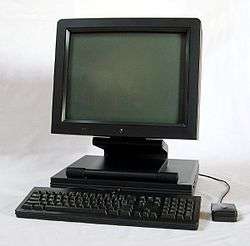Pizza box form factor

In computing, a pizza box is a style of case for computers or network switches. Cases of this type tend to be wide and flat, normally one or two rack units (1U or 2U, 1¾ or 3½ inch, 4.4 or 8.9 cm) in height, thus resembling pizza delivery boxes.
The Data General Aviion Unix server was advertised in 1991 with the tagline "Who just fit mainframe power in a pizza box?",[1] but most computers generally referred to as pizza box systems were high-end desktop systems such as Sun Microsystems workstations sold in the 1990s, most notably the SPARCstation 1 and SPARCstation 5. Other notable examples have been among the highest-performing desktop computers of their generations, including the SGI Indy, the NeXTstation, and the Amiga 1000, but the form factor was also seen in budget and lower-end lines such as the Macintosh LC series.

The original SPARCstation 1 design included an expansion bus technology, SBus, expressly designed for the form factor; expansion cards were small, especially in comparison to other expansion cards in use at the time such as VMEbus, and were mounted horizontally instead of vertically. PC‑compatible computers in this type of case typically use the PCI expansion bus and are usually either a) limited to one or two horizontally placed expansion cards or b) require special low-profile expansion cards, shorter than the PCI cards regular PCs use.[2]
The density of computing power and stackability of pizza box systems also made them attractive for use in data centers. Systems originally designed for desktop use were placed on shelves inside of 19‑inch racks, sometimes requiring that part of their cases be cut off in order for them to fit. Since the late 1990s, pizza boxes have been a common form factor in data centers or industrial applications where rack space and density are critical. Servers in this form factor, as well as higher-end Ethernet switches, are now designed for rack mounting. Rack mount 1U computers come in all types of configurations and depths.
The pizza box form factor for smaller desktop systems and thin clients remains in use, though it is increasingly being superseded by designs that embed the already size-reduced computer onto the keyboard or display monitor.
References
- ↑ "Who just fit mainframe power in a pizza box... [advertisement]". CIO. 4 (7): 59. April 1991. Retrieved March 7, 2015.
- ↑ "Low-Profile PCI". PCI-SIG Frequently Asked Questions. PCI-SIG. Retrieved 2008-02-17.
External links
- Pizza box in the Jargon File